Electrocoagulation for Wastewater Treatment
VerifiedAdded on 2020/04/21
|8
|1729
|38
AI Summary
This solved assignment explores the application of electrocoagulation as a treatment method for distillery wastewater. It details the experimental setup, investigating the impact of pH and electrode type (Al-Al and Fe-Fe) on color and COD removal efficiency. The report also outlines individual contributions to the project, highlighting the collaborative approach adopted.
Contribute Materials
Your contribution can guide someone’s learning journey. Share your
documents today.
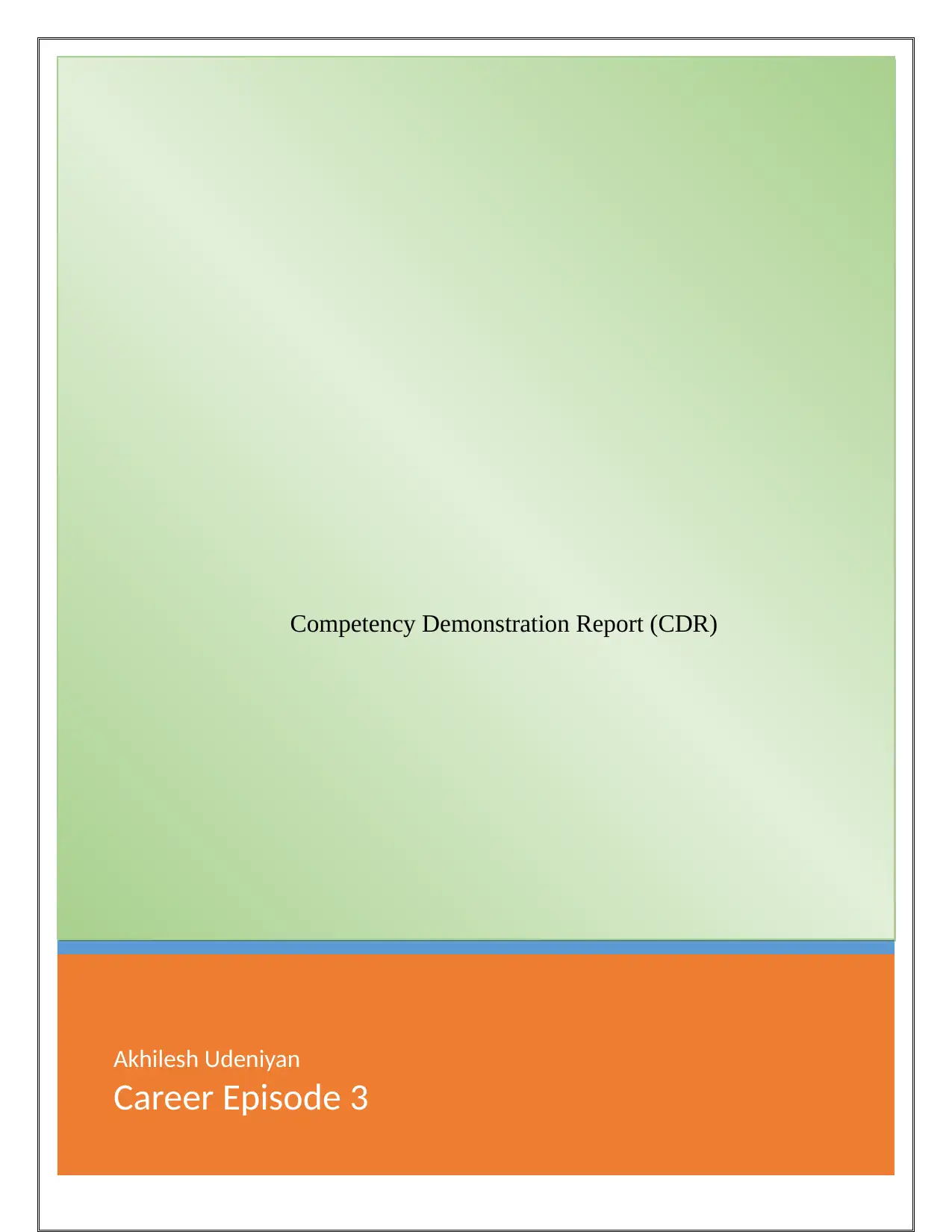
Akhilesh Udeniyan
Career Episode 3
Competency Demonstration Report (CDR)
Career Episode 3
Competency Demonstration Report (CDR)
Secure Best Marks with AI Grader
Need help grading? Try our AI Grader for instant feedback on your assignments.
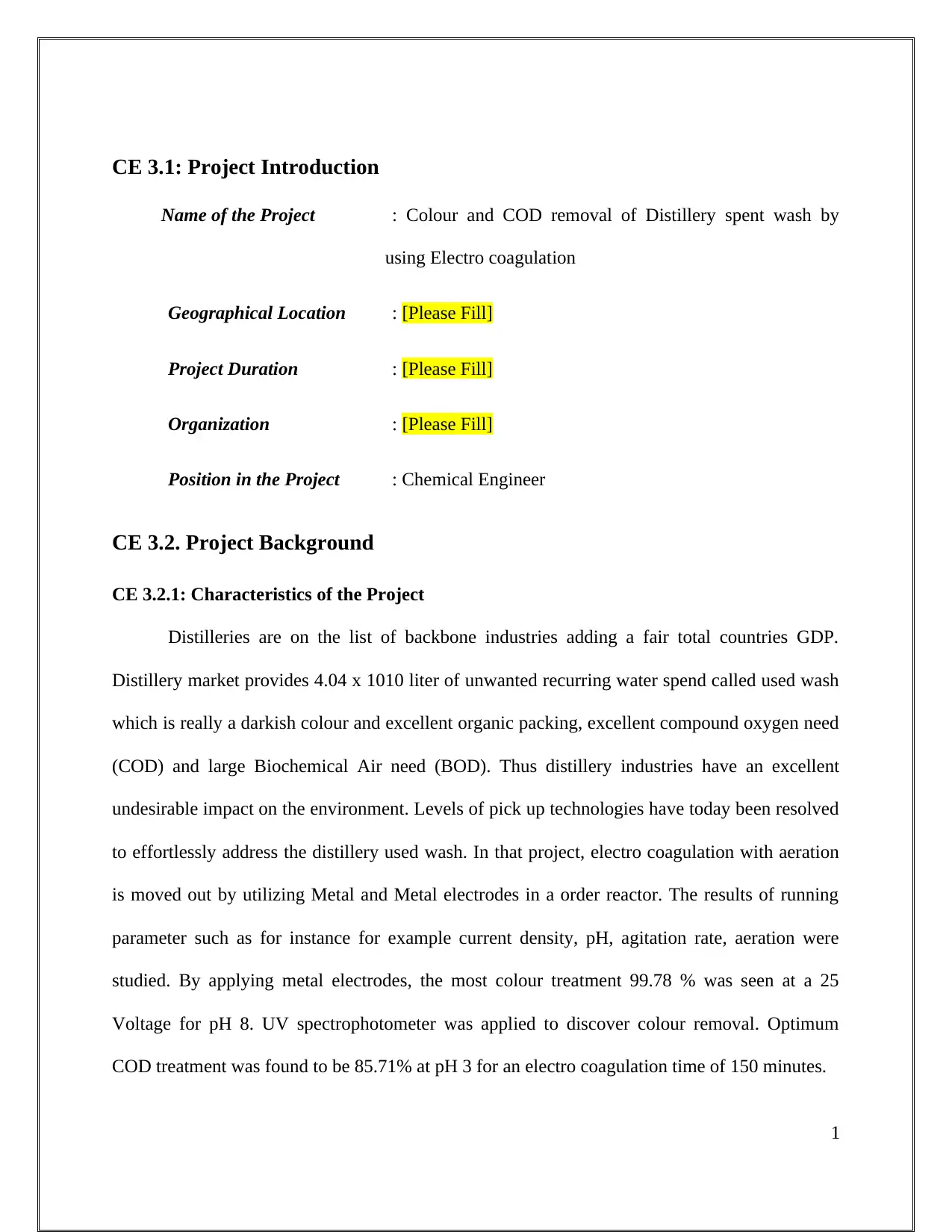
CE 3.1: Project Introduction
Name of the Project : Colour and COD removal of Distillery spent wash by
using Electro coagulation
Geographical Location : [Please Fill]
Project Duration : [Please Fill]
Organization : [Please Fill]
Position in the Project : Chemical Engineer
CE 3.2. Project Background
CE 3.2.1: Characteristics of the Project
Distilleries are on the list of backbone industries adding a fair total countries GDP.
Distillery market provides 4.04 x 1010 liter of unwanted recurring water spend called used wash
which is really a darkish colour and excellent organic packing, excellent compound oxygen need
(COD) and large Biochemical Air need (BOD). Thus distillery industries have an excellent
undesirable impact on the environment. Levels of pick up technologies have today been resolved
to effortlessly address the distillery used wash. In that project, electro coagulation with aeration
is moved out by utilizing Metal and Metal electrodes in a order reactor. The results of running
parameter such as for instance for example current density, pH, agitation rate, aeration were
studied. By applying metal electrodes, the most colour treatment 99.78 % was seen at a 25
Voltage for pH 8. UV spectrophotometer was applied to discover colour removal. Optimum
COD treatment was found to be 85.71% at pH 3 for an electro coagulation time of 150 minutes.
1
Name of the Project : Colour and COD removal of Distillery spent wash by
using Electro coagulation
Geographical Location : [Please Fill]
Project Duration : [Please Fill]
Organization : [Please Fill]
Position in the Project : Chemical Engineer
CE 3.2. Project Background
CE 3.2.1: Characteristics of the Project
Distilleries are on the list of backbone industries adding a fair total countries GDP.
Distillery market provides 4.04 x 1010 liter of unwanted recurring water spend called used wash
which is really a darkish colour and excellent organic packing, excellent compound oxygen need
(COD) and large Biochemical Air need (BOD). Thus distillery industries have an excellent
undesirable impact on the environment. Levels of pick up technologies have today been resolved
to effortlessly address the distillery used wash. In that project, electro coagulation with aeration
is moved out by utilizing Metal and Metal electrodes in a order reactor. The results of running
parameter such as for instance for example current density, pH, agitation rate, aeration were
studied. By applying metal electrodes, the most colour treatment 99.78 % was seen at a 25
Voltage for pH 8. UV spectrophotometer was applied to discover colour removal. Optimum
COD treatment was found to be 85.71% at pH 3 for an electro coagulation time of 150 minutes.
1
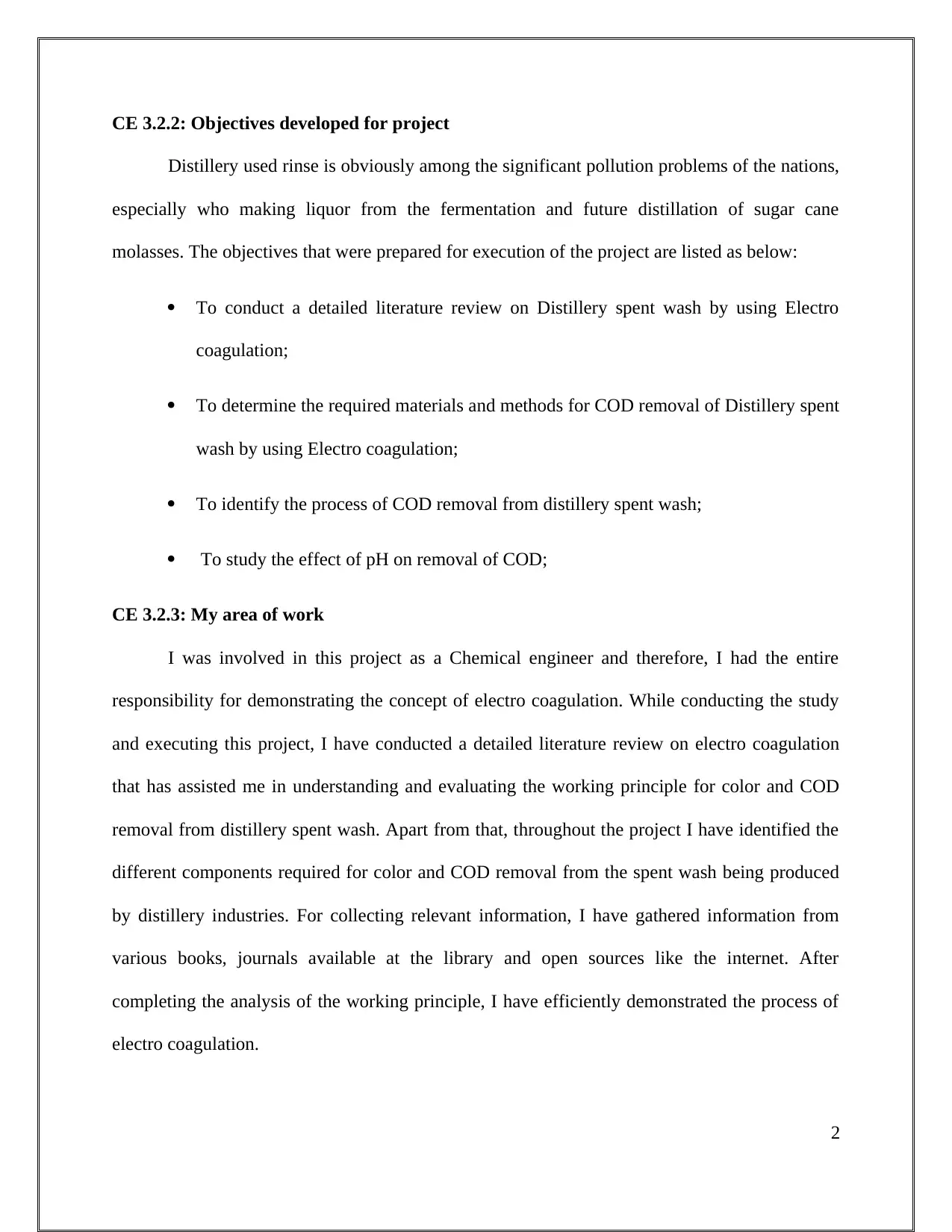
CE 3.2.2: Objectives developed for project
Distillery used rinse is obviously among the significant pollution problems of the nations,
especially who making liquor from the fermentation and future distillation of sugar cane
molasses. The objectives that were prepared for execution of the project are listed as below:
To conduct a detailed literature review on Distillery spent wash by using Electro
coagulation;
To determine the required materials and methods for COD removal of Distillery spent
wash by using Electro coagulation;
To identify the process of COD removal from distillery spent wash;
To study the effect of pH on removal of COD;
CE 3.2.3: My area of work
I was involved in this project as a Chemical engineer and therefore, I had the entire
responsibility for demonstrating the concept of electro coagulation. While conducting the study
and executing this project, I have conducted a detailed literature review on electro coagulation
that has assisted me in understanding and evaluating the working principle for color and COD
removal from distillery spent wash. Apart from that, throughout the project I have identified the
different components required for color and COD removal from the spent wash being produced
by distillery industries. For collecting relevant information, I have gathered information from
various books, journals available at the library and open sources like the internet. After
completing the analysis of the working principle, I have efficiently demonstrated the process of
electro coagulation.
2
Distillery used rinse is obviously among the significant pollution problems of the nations,
especially who making liquor from the fermentation and future distillation of sugar cane
molasses. The objectives that were prepared for execution of the project are listed as below:
To conduct a detailed literature review on Distillery spent wash by using Electro
coagulation;
To determine the required materials and methods for COD removal of Distillery spent
wash by using Electro coagulation;
To identify the process of COD removal from distillery spent wash;
To study the effect of pH on removal of COD;
CE 3.2.3: My area of work
I was involved in this project as a Chemical engineer and therefore, I had the entire
responsibility for demonstrating the concept of electro coagulation. While conducting the study
and executing this project, I have conducted a detailed literature review on electro coagulation
that has assisted me in understanding and evaluating the working principle for color and COD
removal from distillery spent wash. Apart from that, throughout the project I have identified the
different components required for color and COD removal from the spent wash being produced
by distillery industries. For collecting relevant information, I have gathered information from
various books, journals available at the library and open sources like the internet. After
completing the analysis of the working principle, I have efficiently demonstrated the process of
electro coagulation.
2
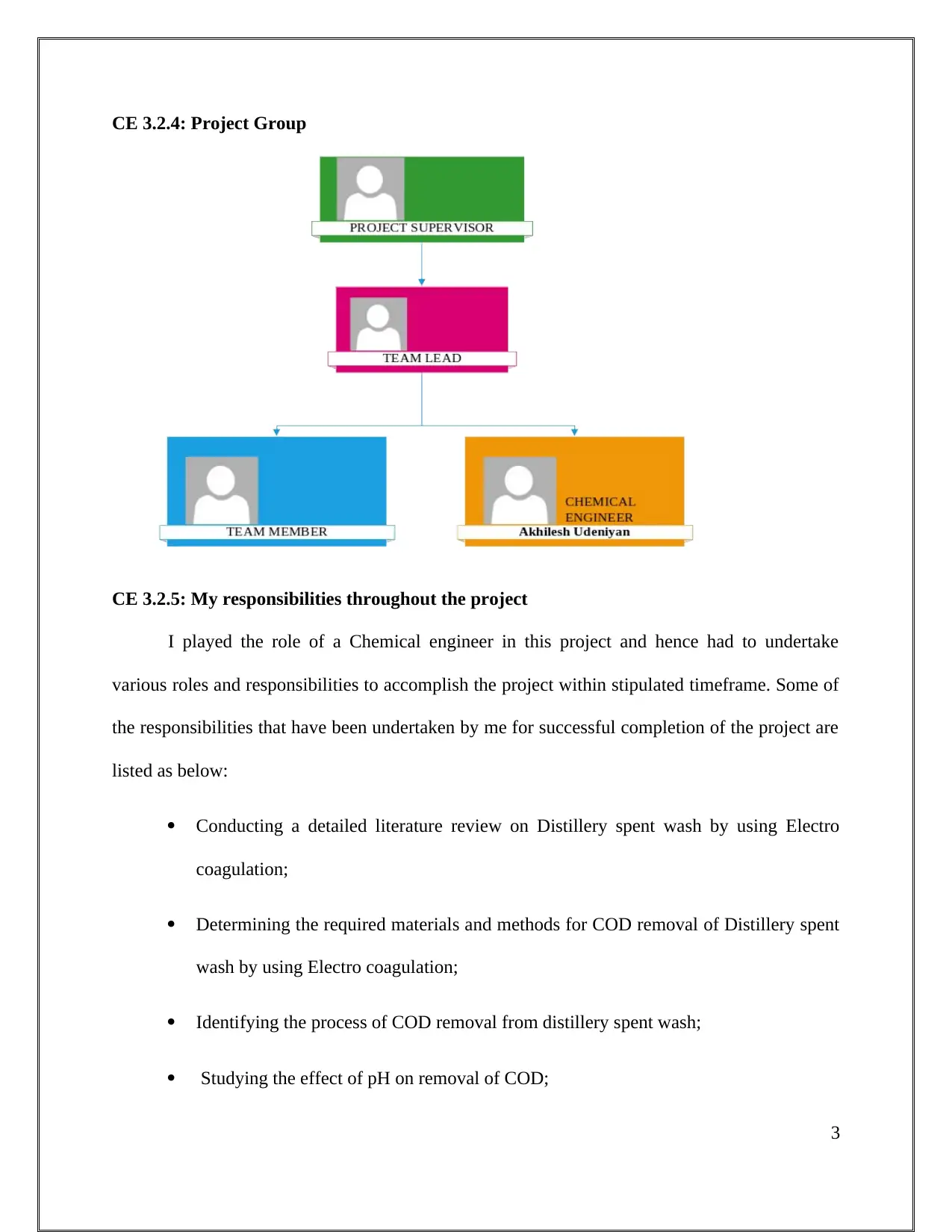
CE 3.2.4: Project Group
CE 3.2.5: My responsibilities throughout the project
I played the role of a Chemical engineer in this project and hence had to undertake
various roles and responsibilities to accomplish the project within stipulated timeframe. Some of
the responsibilities that have been undertaken by me for successful completion of the project are
listed as below:
Conducting a detailed literature review on Distillery spent wash by using Electro
coagulation;
Determining the required materials and methods for COD removal of Distillery spent
wash by using Electro coagulation;
Identifying the process of COD removal from distillery spent wash;
Studying the effect of pH on removal of COD;
3
CE 3.2.5: My responsibilities throughout the project
I played the role of a Chemical engineer in this project and hence had to undertake
various roles and responsibilities to accomplish the project within stipulated timeframe. Some of
the responsibilities that have been undertaken by me for successful completion of the project are
listed as below:
Conducting a detailed literature review on Distillery spent wash by using Electro
coagulation;
Determining the required materials and methods for COD removal of Distillery spent
wash by using Electro coagulation;
Identifying the process of COD removal from distillery spent wash;
Studying the effect of pH on removal of COD;
3
Secure Best Marks with AI Grader
Need help grading? Try our AI Grader for instant feedback on your assignments.
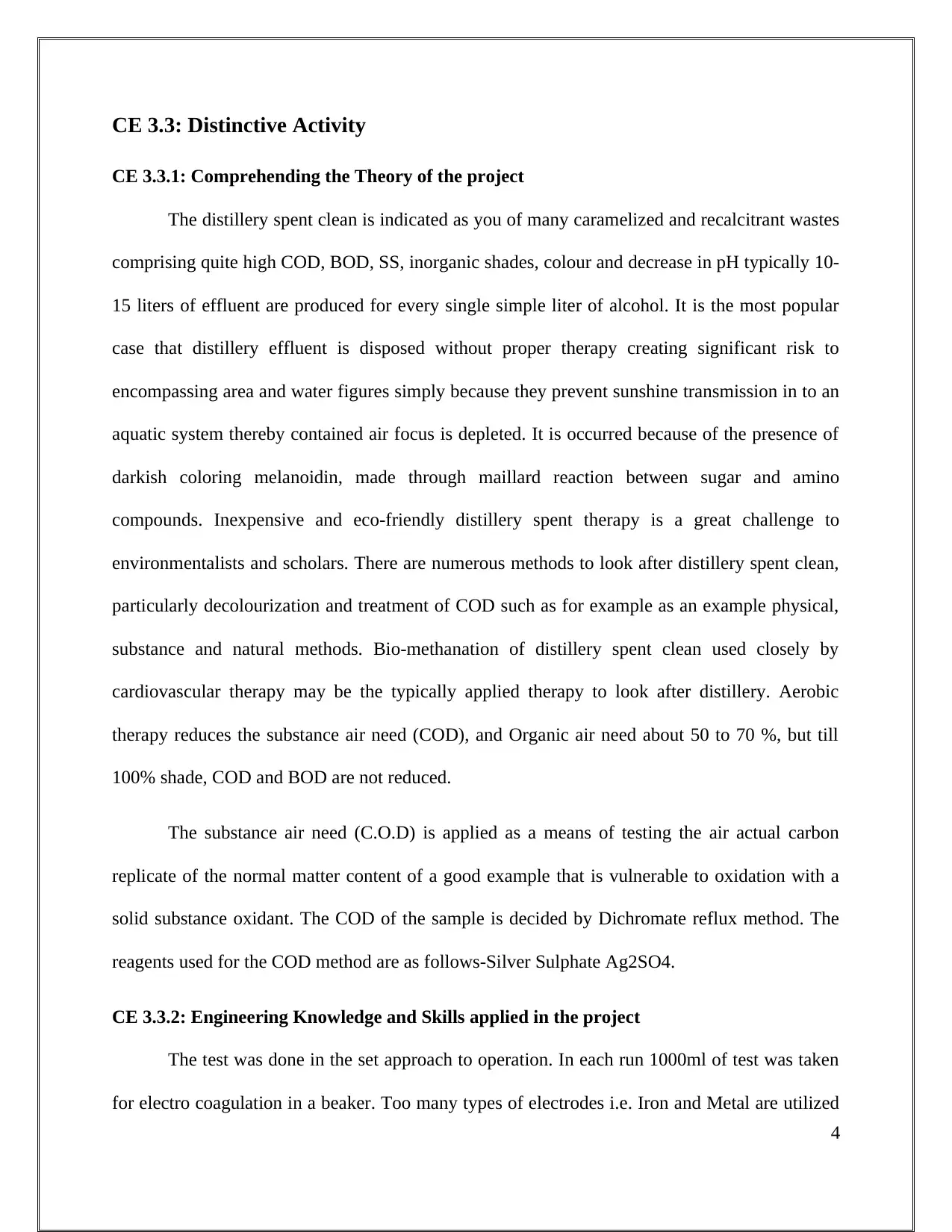
CE 3.3: Distinctive Activity
CE 3.3.1: Comprehending the Theory of the project
The distillery spent clean is indicated as you of many caramelized and recalcitrant wastes
comprising quite high COD, BOD, SS, inorganic shades, colour and decrease in pH typically 10-
15 liters of effluent are produced for every single simple liter of alcohol. It is the most popular
case that distillery effluent is disposed without proper therapy creating significant risk to
encompassing area and water figures simply because they prevent sunshine transmission in to an
aquatic system thereby contained air focus is depleted. It is occurred because of the presence of
darkish coloring melanoidin, made through maillard reaction between sugar and amino
compounds. Inexpensive and eco-friendly distillery spent therapy is a great challenge to
environmentalists and scholars. There are numerous methods to look after distillery spent clean,
particularly decolourization and treatment of COD such as for example as an example physical,
substance and natural methods. Bio-methanation of distillery spent clean used closely by
cardiovascular therapy may be the typically applied therapy to look after distillery. Aerobic
therapy reduces the substance air need (COD), and Organic air need about 50 to 70 %, but till
100% shade, COD and BOD are not reduced.
The substance air need (C.O.D) is applied as a means of testing the air actual carbon
replicate of the normal matter content of a good example that is vulnerable to oxidation with a
solid substance oxidant. The COD of the sample is decided by Dichromate reflux method. The
reagents used for the COD method are as follows-Silver Sulphate Ag2SO4.
CE 3.3.2: Engineering Knowledge and Skills applied in the project
The test was done in the set approach to operation. In each run 1000ml of test was taken
for electro coagulation in a beaker. Too many types of electrodes i.e. Iron and Metal are utilized
4
CE 3.3.1: Comprehending the Theory of the project
The distillery spent clean is indicated as you of many caramelized and recalcitrant wastes
comprising quite high COD, BOD, SS, inorganic shades, colour and decrease in pH typically 10-
15 liters of effluent are produced for every single simple liter of alcohol. It is the most popular
case that distillery effluent is disposed without proper therapy creating significant risk to
encompassing area and water figures simply because they prevent sunshine transmission in to an
aquatic system thereby contained air focus is depleted. It is occurred because of the presence of
darkish coloring melanoidin, made through maillard reaction between sugar and amino
compounds. Inexpensive and eco-friendly distillery spent therapy is a great challenge to
environmentalists and scholars. There are numerous methods to look after distillery spent clean,
particularly decolourization and treatment of COD such as for example as an example physical,
substance and natural methods. Bio-methanation of distillery spent clean used closely by
cardiovascular therapy may be the typically applied therapy to look after distillery. Aerobic
therapy reduces the substance air need (COD), and Organic air need about 50 to 70 %, but till
100% shade, COD and BOD are not reduced.
The substance air need (C.O.D) is applied as a means of testing the air actual carbon
replicate of the normal matter content of a good example that is vulnerable to oxidation with a
solid substance oxidant. The COD of the sample is decided by Dichromate reflux method. The
reagents used for the COD method are as follows-Silver Sulphate Ag2SO4.
CE 3.3.2: Engineering Knowledge and Skills applied in the project
The test was done in the set approach to operation. In each run 1000ml of test was taken
for electro coagulation in a beaker. Too many types of electrodes i.e. Iron and Metal are utilized
4
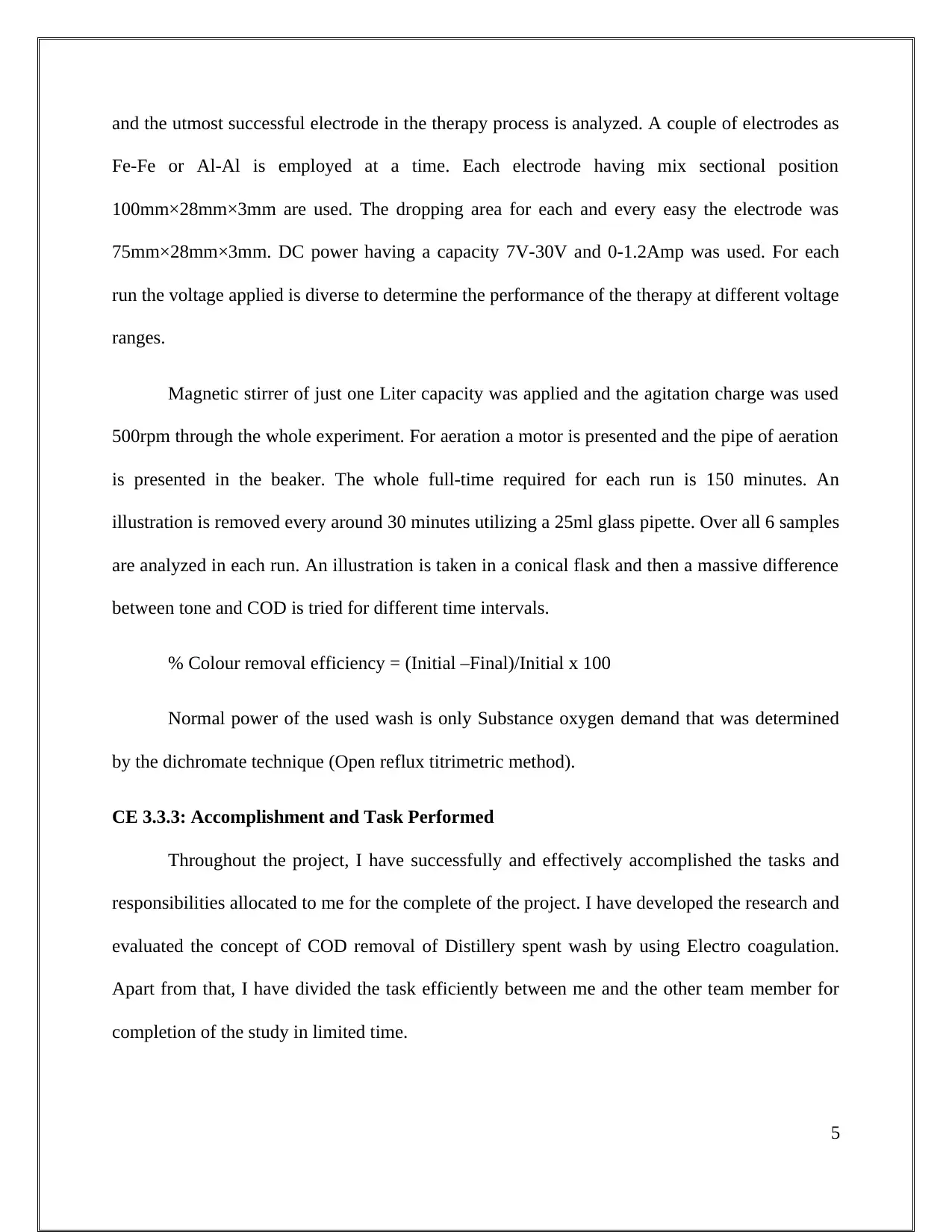
and the utmost successful electrode in the therapy process is analyzed. A couple of electrodes as
Fe-Fe or Al-Al is employed at a time. Each electrode having mix sectional position
100mm×28mm×3mm are used. The dropping area for each and every easy the electrode was
75mm×28mm×3mm. DC power having a capacity 7V-30V and 0-1.2Amp was used. For each
run the voltage applied is diverse to determine the performance of the therapy at different voltage
ranges.
Magnetic stirrer of just one Liter capacity was applied and the agitation charge was used
500rpm through the whole experiment. For aeration a motor is presented and the pipe of aeration
is presented in the beaker. The whole full-time required for each run is 150 minutes. An
illustration is removed every around 30 minutes utilizing a 25ml glass pipette. Over all 6 samples
are analyzed in each run. An illustration is taken in a conical flask and then a massive difference
between tone and COD is tried for different time intervals.
% Colour removal efficiency = (Initial –Final)/Initial x 100
Normal power of the used wash is only Substance oxygen demand that was determined
by the dichromate technique (Open reflux titrimetric method).
CE 3.3.3: Accomplishment and Task Performed
Throughout the project, I have successfully and effectively accomplished the tasks and
responsibilities allocated to me for the complete of the project. I have developed the research and
evaluated the concept of COD removal of Distillery spent wash by using Electro coagulation.
Apart from that, I have divided the task efficiently between me and the other team member for
completion of the study in limited time.
5
Fe-Fe or Al-Al is employed at a time. Each electrode having mix sectional position
100mm×28mm×3mm are used. The dropping area for each and every easy the electrode was
75mm×28mm×3mm. DC power having a capacity 7V-30V and 0-1.2Amp was used. For each
run the voltage applied is diverse to determine the performance of the therapy at different voltage
ranges.
Magnetic stirrer of just one Liter capacity was applied and the agitation charge was used
500rpm through the whole experiment. For aeration a motor is presented and the pipe of aeration
is presented in the beaker. The whole full-time required for each run is 150 minutes. An
illustration is removed every around 30 minutes utilizing a 25ml glass pipette. Over all 6 samples
are analyzed in each run. An illustration is taken in a conical flask and then a massive difference
between tone and COD is tried for different time intervals.
% Colour removal efficiency = (Initial –Final)/Initial x 100
Normal power of the used wash is only Substance oxygen demand that was determined
by the dichromate technique (Open reflux titrimetric method).
CE 3.3.3: Accomplishment and Task Performed
Throughout the project, I have successfully and effectively accomplished the tasks and
responsibilities allocated to me for the complete of the project. I have developed the research and
evaluated the concept of COD removal of Distillery spent wash by using Electro coagulation.
Apart from that, I have divided the task efficiently between me and the other team member for
completion of the study in limited time.
5
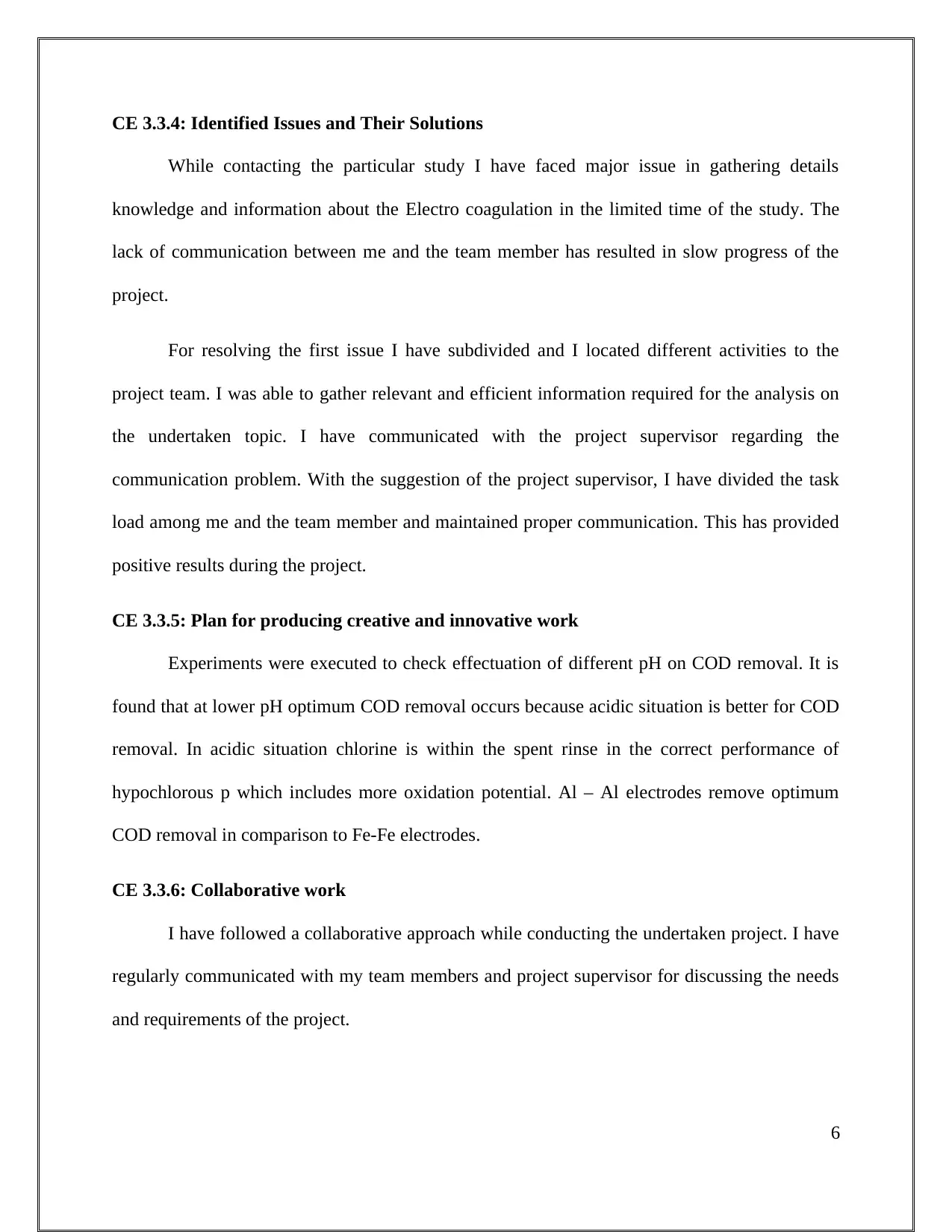
CE 3.3.4: Identified Issues and Their Solutions
While contacting the particular study I have faced major issue in gathering details
knowledge and information about the Electro coagulation in the limited time of the study. The
lack of communication between me and the team member has resulted in slow progress of the
project.
For resolving the first issue I have subdivided and I located different activities to the
project team. I was able to gather relevant and efficient information required for the analysis on
the undertaken topic. I have communicated with the project supervisor regarding the
communication problem. With the suggestion of the project supervisor, I have divided the task
load among me and the team member and maintained proper communication. This has provided
positive results during the project.
CE 3.3.5: Plan for producing creative and innovative work
Experiments were executed to check effectuation of different pH on COD removal. It is
found that at lower pH optimum COD removal occurs because acidic situation is better for COD
removal. In acidic situation chlorine is within the spent rinse in the correct performance of
hypochlorous p which includes more oxidation potential. Al – Al electrodes remove optimum
COD removal in comparison to Fe-Fe electrodes.
CE 3.3.6: Collaborative work
I have followed a collaborative approach while conducting the undertaken project. I have
regularly communicated with my team members and project supervisor for discussing the needs
and requirements of the project.
6
While contacting the particular study I have faced major issue in gathering details
knowledge and information about the Electro coagulation in the limited time of the study. The
lack of communication between me and the team member has resulted in slow progress of the
project.
For resolving the first issue I have subdivided and I located different activities to the
project team. I was able to gather relevant and efficient information required for the analysis on
the undertaken topic. I have communicated with the project supervisor regarding the
communication problem. With the suggestion of the project supervisor, I have divided the task
load among me and the team member and maintained proper communication. This has provided
positive results during the project.
CE 3.3.5: Plan for producing creative and innovative work
Experiments were executed to check effectuation of different pH on COD removal. It is
found that at lower pH optimum COD removal occurs because acidic situation is better for COD
removal. In acidic situation chlorine is within the spent rinse in the correct performance of
hypochlorous p which includes more oxidation potential. Al – Al electrodes remove optimum
COD removal in comparison to Fe-Fe electrodes.
CE 3.3.6: Collaborative work
I have followed a collaborative approach while conducting the undertaken project. I have
regularly communicated with my team members and project supervisor for discussing the needs
and requirements of the project.
6
Paraphrase This Document
Need a fresh take? Get an instant paraphrase of this document with our AI Paraphraser
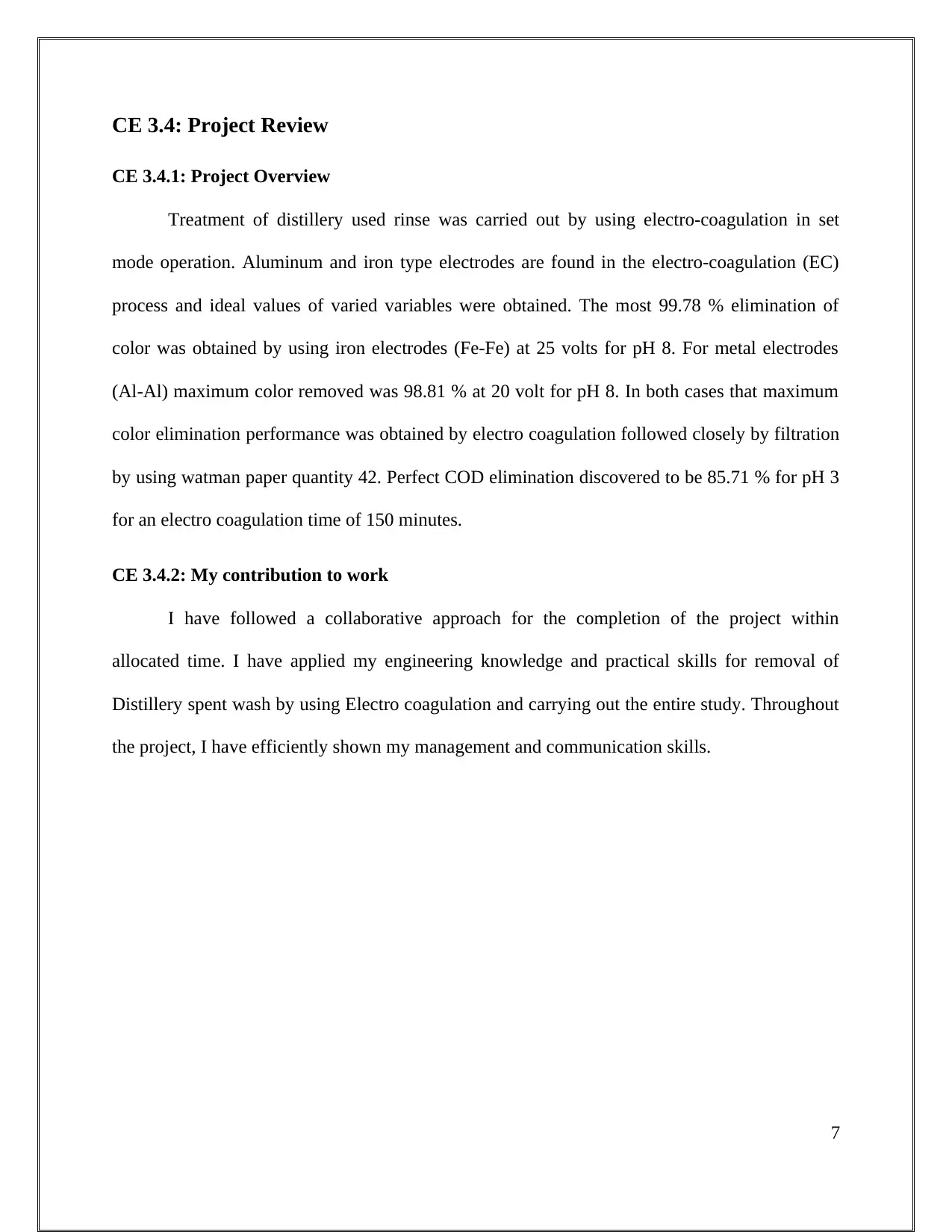
CE 3.4: Project Review
CE 3.4.1: Project Overview
Treatment of distillery used rinse was carried out by using electro-coagulation in set
mode operation. Aluminum and iron type electrodes are found in the electro-coagulation (EC)
process and ideal values of varied variables were obtained. The most 99.78 % elimination of
color was obtained by using iron electrodes (Fe-Fe) at 25 volts for pH 8. For metal electrodes
(Al-Al) maximum color removed was 98.81 % at 20 volt for pH 8. In both cases that maximum
color elimination performance was obtained by electro coagulation followed closely by filtration
by using watman paper quantity 42. Perfect COD elimination discovered to be 85.71 % for pH 3
for an electro coagulation time of 150 minutes.
CE 3.4.2: My contribution to work
I have followed a collaborative approach for the completion of the project within
allocated time. I have applied my engineering knowledge and practical skills for removal of
Distillery spent wash by using Electro coagulation and carrying out the entire study. Throughout
the project, I have efficiently shown my management and communication skills.
7
CE 3.4.1: Project Overview
Treatment of distillery used rinse was carried out by using electro-coagulation in set
mode operation. Aluminum and iron type electrodes are found in the electro-coagulation (EC)
process and ideal values of varied variables were obtained. The most 99.78 % elimination of
color was obtained by using iron electrodes (Fe-Fe) at 25 volts for pH 8. For metal electrodes
(Al-Al) maximum color removed was 98.81 % at 20 volt for pH 8. In both cases that maximum
color elimination performance was obtained by electro coagulation followed closely by filtration
by using watman paper quantity 42. Perfect COD elimination discovered to be 85.71 % for pH 3
for an electro coagulation time of 150 minutes.
CE 3.4.2: My contribution to work
I have followed a collaborative approach for the completion of the project within
allocated time. I have applied my engineering knowledge and practical skills for removal of
Distillery spent wash by using Electro coagulation and carrying out the entire study. Throughout
the project, I have efficiently shown my management and communication skills.
7
1 out of 8
Related Documents
Your All-in-One AI-Powered Toolkit for Academic Success.
+13062052269
info@desklib.com
Available 24*7 on WhatsApp / Email
![[object Object]](/_next/static/media/star-bottom.7253800d.svg)
Unlock your academic potential
© 2024 | Zucol Services PVT LTD | All rights reserved.





